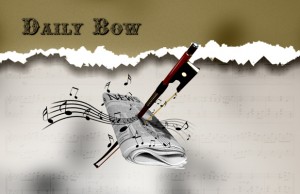 Classical music in clubs, once something new and unheard of, has become almost de rigeur in the classical music scene. We’ve come a long way from being startled at Matt Haimovitz’s Bach in bars campaign, and almost every up-and-coming string quartet has made appearances in non-standard venues, whether it be a club or a coffee house or a bar. Classical Revolution has made an almost standardized practice out of taking classical music out of the concert hall, and it seems that the out-of-the-box movement has become a bonafide staple, courtesy of a network of independent grassroots initiatives. In fact, the classical club presence has become so much of a staple that it is in and of itself becoming somewhat institutionalized. Case in point: the Universal record label’s Yellow Lounge.
Classical music in clubs, once something new and unheard of, has become almost de rigeur in the classical music scene. We’ve come a long way from being startled at Matt Haimovitz’s Bach in bars campaign, and almost every up-and-coming string quartet has made appearances in non-standard venues, whether it be a club or a coffee house or a bar. Classical Revolution has made an almost standardized practice out of taking classical music out of the concert hall, and it seems that the out-of-the-box movement has become a bonafide staple, courtesy of a network of independent grassroots initiatives. In fact, the classical club presence has become so much of a staple that it is in and of itself becoming somewhat institutionalized. Case in point: the Universal record label’s Yellow Lounge.
So what is Yellow Lounge? Yellow Lounge is a concert series that started eight years ago in Berlin and has since caught on in the U.K. The series is run by the Universal label, who sets up the concerts on a semi-regular basis. The concerts feature music in unconventional venues (clubs, lounges, bars, etc.), all for 10 pounds (in London). The nights include classical music being DJ’ed throughout the night, some video art installations, and interaction from the artists. The primary goal of the Yellow Lounge concerts is, in the words of Universal label executive Bee Bradley, “to engage with a new young audience. So many youngsters would get into classical music but don’t know where to start, don’t want to sit in concert halls or spend $100 on a ticket.” So Universal has decided to pitch the rules and the conventions out the door–but the one thing that stays, no matter what, is the quality of the music, the artists, and the repertoire. The pull of the label allows the concerts to feature well-known artists (one recent concert featured violin super-star Janine Jansen). Often, though, Bradley says that the young audience (around 18-40) is uninitiated and doesn’t know that they might otherwise be paying a fortune for a ticket to a concert with Janine Jansen.
The club phenomenon is particularly healthy in Britain, where it is evolving as a parallel supplement to–not substitute for–the traditional classical scene. Violinist Thomas Gould, concertmaster of the British Sinfonia, has appeared at London club Platform 33, which launched in January, and has presented 40 different mixed-media clubnights all over the city. He views such events more as marketing tools, saying, “I don’t do them to make money. Twitter always goes crazy after these events. It’s a great way to have a direct line of communication with audiences.” However, he’s of the opinion that the buzz isn’t going to create a changed classical music scene as a whole. He says, “It’s a separate industry that’s evolved. People will still go to the Wigmore Hall.”
Traditional institutions like the Universal label are wisely putting one foot in each camp. So it is with the extremely traditional Orchestra of the Age of Enlightenment, which is a bastion of impeccable reputation within the musical community. Surprisingly, they have been running their own classical clubnight, which they call “The Night Shift.” More surprisingly, it’s in its sixth year and is trading on totally standard repertoire. It’s just the format that they have changed, and it has resulted in great success. The format is the same as a clubnight–concerts kick off at 10pm and feature a free flow of alcohol and food (as well as audience members–who can come and go as in a jazz or rock concert). The lights are low and so are the ticket prices: tickets range from £9 ($14) in advance to £4 ($6) for students. Says the Orchestra of the Age of Enlightenment’s public relations manager William Norris, “We started out with the idea that the music still has appeal, it’s just the way it’s presented that doesn’t appeal to some audiences, particularly younger ones. The music we play is the same as we’d play in a ‘normal’ concert.” The way that he sees it, it’s not the material that has been causing a drop in attendance–it’s the format. The Night Shift is doing something, like Yellow Lounge, that many other traditional classical institutions has been struggling with: scoring with the coveted younger demographic–the demographic that can carry classical music into the future. Says Norris, “The audience is massively skewed to being under 35 (over 80%) and 15-20% are coming to a classical concert for the first time.”
Most importantly, though, the content is the same. Rather than pulling out the crossover rep or bending genres, the repertoire for these clubnights is overwhelmingly classical–and it’s successful. Norris explains: “The music we play is the same high quality as we’d play at 7pm, so it doesn’t matter in which context you experience it. Some people may always want to enjoy their music in a more relaxed late night setting and that’s fine, so there’s no point trying to tempt them into a more regular event, it’s about giving them a choice as to how they’d like to experience their music.”














No comments yet.